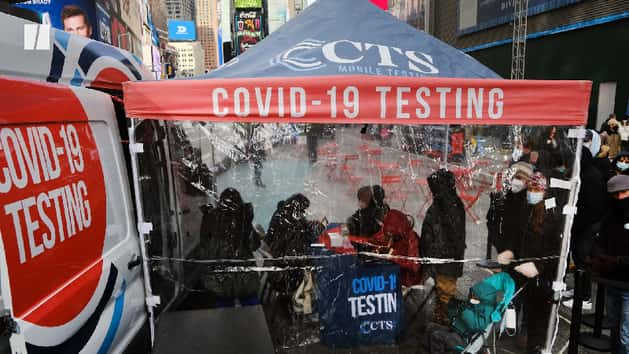Nurses are raising concerns about the latest guidance from the Centers for Disease Control and Prevention that halves the recommended isolation time for people who test positive for COVID-19 — and can be further reduced for those who work in fields with severe staffing shortages, like health care.
On Wednesday, the American Nurses Association said it is “deeply concerned” about the latest guidance and how it will impact COVID-19 case rates, as well as the safety of health care workers, as the highly transmissible omicron variant spreads across the country.
“This guidance is premature given what is known about the Omicron variant and tips toward economic needs as opposed to the health needs of nurses and other health care workers,” the organization said in a statement. “ANA is concerned that the return-to-work guidance for all health care personnel under the updated mitigation strategies will endanger the health and safety of health care workers and those they encounter.”
On Dec. 23, the CDC loosened rules that previously called for health care personnel to stay out of the workplace for 10 days if they test positive. The guidance said that workers can go back after seven days if they test negative and are asymptomatic, though isolation time could be cut to five days or fewer in light of staffing shortages.
Just four days later, the CDC is changed the isolation guidance for the general public to be even less stringent. As of Monday, Americans are recommended to isolate themselves for only five days from the time they test positive, and can return to normal activities with a mask if they are asymptomatic. The new recommendation did not explicitly say that people should test negative before exiting isolation.
Dr. Megan Ranney, an emergency room physician at Brown University who has provided guidance in the media on navigating the pandemic, tweeted a lengthy thread on Monday in response to the new guidelines. While the recommendations sound great for vaccinated, asymptomatic people who want to get back to school, work and play, “the devil’s in the details, my friends,” she said.
“On the one hand: I’m all for following the science for the vaccinated and asymptomatic. No reason to keep people home unnecessarily,” Ranney said, applauding the CDC for recognizing that what the scientific community knows about COVID-19 has changed. “On the other hand: the data shows a RANGE of infectiousness. Requiring a rapid test before ending isolation (esp for folks like, say, healthcare workers) would be far, far, far safer.”
Ranney also expressed fear that the guidance will “too easily move to ‘go back to work when you have symptoms,’” and told CNN that she suspects Monday’s announcement was “at least partly because of pressure from employers.” She added that, while the CDC recommends that those who tested positive wear a mask after isolating for five days, it’s unrealistic to expect people who are willfully unvaccinated to mask up in public.
Health care workers are the last line of defense in the pandemic, but the industry is facing a huge nurse shortage, said Kathryn, an ICU nurse in Nebraska who asked that her last name not be published.
“How can we take care of others when we aren’t able to properly care for ourselves? We cannot pour from an empty cup,” she told HuffPost. “I worry this might be the last straw for many nurses; jeopardizing our own health to fix the staffing crisis.”
ANA President Ernest J. Grant called on the CDC to reconsider the guidelines, and asked policymakers to “aggressively pursue other strategies to bolster the health care system.” The association already met with and provided comments to the CDC expressing its concerns about the changes. In September, it urged the Department of Health and Human Services to declare the country’s current and unsustainable nurse staffing shortage a national crisis.
“At the end of the day, this pandemic has been our everyday life for the last 2-plus years. It has been a nightmare, to say the least. We are so tired. We are hurting,” Kathryn said. “These guidelines need to protect health care staff. I worry that those who fall ill with COVID will not be able to take the time they need to heal and rest due to the concerns of a staffing crisis.”
The latest CDC guidance comes as infection rates soar to the highest level on record, averaging 265,000 new cases per day. The previous mark, set in mid-January soon after the vaccine was released, was 250,000 cases per day, according to data collected by Johns Hopkins University. COVID-19 deaths in the U.S. have climbed over the past two weeks from an average of 1,200 daily deaths to about 1,500.

